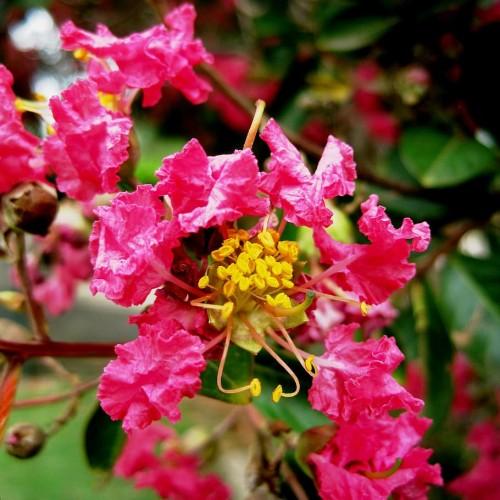
crape myrtle
Lagerstroemia 'Country Red'
Cycle:
Perennial
Watering:
Average
Hardiness Zone:
6 - 9
Flowers:
Flowers
Sun:
Full sun
Leaf:
Yes
Growth Rate:
High
Maintenance:
Moderate
Drought Tolerant:
Yes
watering
Crape Myrtle (Lagerstroemia 'Country Red') should receive about 1 inch of water each week in the spring and summer. Water deeply but infrequently to encourage healthy root development. Water if the top inch of soil appears dry to the touch. It is recommended to water your Crape Myrtles in the morning so they are able to dry off during the day. It is also essential to provide Crape Myrtles with the proper amount of nutrients in order to ensure healthy growth. Fertilize your Crape Myrtles in the spring and again in midsummer with an organic fertilizer or a slow release fertilizer.
sunlight
Crape myrtle (Lagerstroemia 'Country Red') grows best in full sun, meaning that it should receive direct sunlight for at least 6 to 8 hours per day. If possible, the best sun exposure for a crape myrtle is an area with full sun in the morning and filtered sunlight (such as under a shade tree) in the afternoon. To ensure maximum flowering, however, the plant should receive several hours of direct sunlight in the afternoon as well. Evening shade is beneficial for most varieties of crape myrtle, as too much sun exposure for too long can cause leaf scorching.
pruning
Crape myrtles (Lagerstroemia 'Country Red') should be pruned on an annual basis. Pruning should begin when the crape myrtle is about 7 feet tall. Pruning should be focused on the tips of the branches and any limbs that are damaged, diseased, or crossing over each other. Remove the branches 1 at a time, using sharp, clean pruning shears. It is good to prune about a third of the growth each year in order to keep the plant compact and full. Remove any suckers that are growing underneath or around the base of the plant. Suckers can also be pruned shortly after blooming. If the crape myrtle is overgrown, hard pruning can be done in late winter or early spring every 2 to 3 years. Dead or diseased wood should be removed any time of year.
